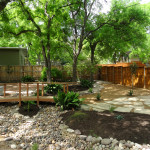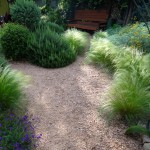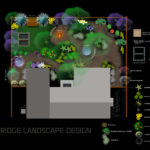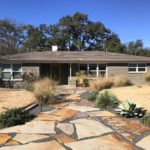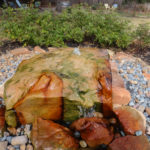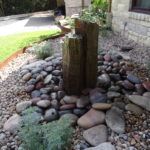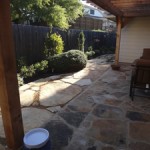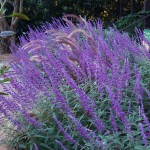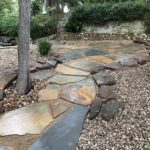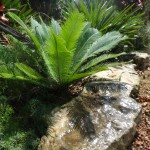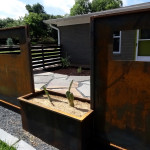
Here is the poor wizened chap – the 20ft flower stalk is still upright but has finished blooming (you can see the debris from the flowers building up). The Agave is dying from the leaf tips inward. I am going to follow and post pictures of the gradual decay of this plant.

Here is the bean stalk – all the flowers have died now. A detail of the trunk reveals hundreds of baby plants? will these drop off and grow? I have no idea.
. . . .and now for some running Bamboo in Stock Tanks :
Here is my latest stock tank addition (4ftx2ft). This one contains a black bamboo (Phyllostachy Nigra) – the black culms against the neighbouring fuchsia Oleander will provide a good color contrast. The broad-leaf Loquat will act as a backdrop for the fine leaves of the bamboo to complete the trio. All these plants are young – I will revisit next year to see if the scene develops like I hope it will. I am also planning to plant in front of the tank to soften its base, perhaps Cast Iron plant? anyone have suggestions ? – Fyi : pretty shady area with late afternoon sun.
This plant has been in numerous containers over the last few years, all too small, and as such the plant has struggled. Even though the bamboo is 4 years old it is quite stunted and the culms are very small. I am hoping that this “pot” will be large enough to finally give it a kick-start. I have had success with this container planting method with a Golden Bamboo (Phyllostachys aurea) in the front of my house so I thought I would repeat it.
Here is a Golden Bamboo 3 weeks after transplanting and lots of new culms.
The technique is simple:
1) Take one stock tank and with a metal drill bit proceed to drill a lot of holes through the base – this job makes your fillings drop out but it is well worth the effort. Elevate the tank.
2) Fill the base with broken tile, bricks, stones etc, any slag will do (remember bamboo loves to fast drain) – just be sure not to cover up the drainage holes. You can then either use smaller rocks to a depth of 8-10 inches or put a layer of weed barrier fabric on top of the slag then just add soil – the fabric stops the soil from filtering down and blocking the drainage holes.
3) I then fill the tank to about 4inches from the top with “Miracle Grow” potting soil with Perlite – I never use Miracle Grow products as a general rule but it really seems to work well in this particular application. I also mix in an additional 1/2 bag of Perlite for even better water retention.
4) Finally add 3-4inches of bark mulch to the top of the cake to help regulate soil and moisture.temperatures.
5} I just realized how much of a nerd I am after writing all of the above.
As a side note, although this container is on the large side (especially in the cooler states) I believe it’s size to be the “sweet-spot” for a Texas bamboo container if you have the space. Small containers in Texas are as much use as the toilet they installed on the international space station.
Other extroverts in the yard right now:

Amaranthus, collectively known as amaranth or pig-weed running amok in my front yard – will put on a
good show in the fall. The word comes from the Greek amarantos “one that does not wither,” or the never-fading (flower).

The National Flower of Barbados is the Pride of Barbados
(Dwarf Poinciana or Flower Fence). Great tropical leaves!

Sticking on the Barbados theme – the Barbados cherry is native to the Lesser Antilles from St. Croix to Trinidad, also Curacao and Margarita and neighboring northern South America as far south as Brazil. Mine is one of the smaller varieties and it is packed with cherries right now. When it was flowering it was hard to even walk past this plant for the large numbers of bees that would swarm. I think my neighbors must have thought it strange that I repeatedly had a flailing spasm exactly in the same place down my pathway, every-time I would walk past it.
Stay Tuned for:
“The Bermuda Triangle”
All material © 2009 for eastsidepatch. Unauthorized
intergalactic reproduction strictly prohibited, and
punishable by late (and extremely unpleasant)
14th century planet Earth techniques.










